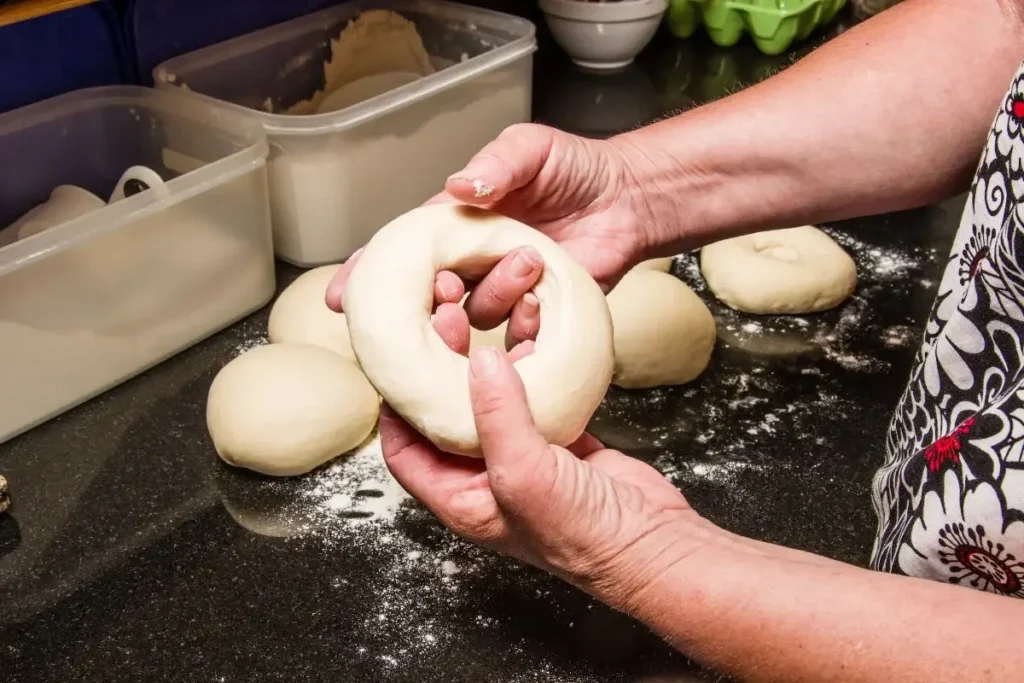
Tired of your bagels getting stale before you can finish them? No worries! We’ve got the perfect solution for you—freezing bagel dough.
In this guide, we’ll take you through the simple steps to freeze bagel dough, ensuring you can enjoy fresh, homemade bagels whenever you want. Freezing bagel dough is a practical way to make your favorite breakfast treat last longer. With just a bit of extra effort to prepare and freeze the dough, you’ll have a stash of bagels ready to bake whenever a craving hits.
Whether you’re a seasoned baker or new to making bagels, this guide is for you. We’ll cover everything from getting the dough ready for freezing to storing it for freshness and the best methods to thaw and bake your bagels. With our tips and tricks, you won’t have to worry about stale bagels again.
Ready to extend the life of your beloved bagels? Join us as we explore the ultimate guide to freezing bagel dough.
Table of Contents
ToggleWhy freeze Bagel Dough?
Freezing bagel dough is a smart cooking move that brings both convenience and extra flavor to the table. When you freeze bagel dough, you make baking a breeze and gain some flexibility with your time.
You can prep the dough ahead of time, shape it into bagel form, freeze it, and whenever you get a hankering for fresh bagels, just grab the frozen dough, let it thaw, and start baking. It’s a time-saving and efficient way to go about it.
And there’s a bonus – freezing bagel dough can actually make your bagels taste even better. The slow fermentation process during freezing lets the yeast in the dough do its thing gradually, giving your bagels a richer taste and texture. The longer fermentation time improves the overall quality, serving up a more complex and satisfying flavor.
Tips for Preparing Bagel Dough for Freezing
Preparing bagel dough for freezing requires careful consideration to ensure optimal results when it’s time to bake. Here are essential tips for effectively freezing bagel dough:
- Proper Portioning: Divide the bagel dough into individual portions before freezing. This not only facilitates quicker thawing but also allows for convenient batch baking. Portioning ensures that you can thaw and bake only the amount needed, preventing unnecessary waste.
- Shape Before Freezing: Shape the bagel dough into its final form before freezing. Whether you prefer the traditional ring shape or a more creative twist, shaping the dough in advance ensures that it’s ready for baking once thawed. This step saves time and guarantees consistent bagel shapes.
- Wrap Airtight: Wrap each portion of bagel dough tightly in plastic wrap or use a vacuum-sealed bag to create an airtight seal. This prevents freezer burn and maintains the dough’s freshness and quality. Label each package with the date to keep track of freshness. Aim to use the frozen dough within 1-2 months for the best results.
- Flash Freeze Individual Pieces: If you’re freezing smaller portions or bagel balls, consider flash freezing them on a baking sheet before transferring to a storage container. Flash freezing prevents the pieces from sticking together, making it easier to retrieve and thaw only the quantity needed
- Avoid Toppings: While it might be tempting to freeze bagel dough with toppings, it’s generally best to freeze plain dough. Toppings like seeds or dried fruits can lose their texture and taste during the freezing and thawing process, affecting the overall quality of your bagels.
- Room for Expansion: Leave some room for the dough to expand in the freezer container. This accounts for any slight expansion that may occur during freezing, preventing the dough from becoming misshapen.

Thawing and Proofing Frozen Bagel Dough
Now that you’ve successfully frozen your bagel dough, the next crucial step is the thawing and proofing process. This phase is vital to ensure your bagels rise properly and maintain that coveted chewy texture. Let’s delve into the specifics of thawing and proofing frozen bagel dough for the best possible results.
To initiate the revival of your frozen bagel dough, start by transferring it from the freezer to the refrigerator. Thawing the dough slowly in the refrigerator is a gentle method that prevents drastic temperature changes, preserving the integrity of the dough. Depending on the size of your dough portions, this process can take anywhere from several hours to overnight.
Once the dough is fully thawed, it’s time to move on to the proofing stage. Proofing is the final rise that gives bagels their characteristic light and airy interior. Allow the dough to come to room temperature before initiating the proofing process. Find a warm, draft-free space for your dough to rest, covering it with a damp cloth to prevent it from drying out.
The duration of proofing varies, but a general guideline is around 1 to 2 hours. Keep an eye on the dough as it should roughly double in size. To test if the dough is ready, gently press a finger into the surface. If the indentation remains, your bagel dough is adequately proofed and ready for the next steps in the baking process.
Proper Storage Technique for Frozen Bagel Dough
Storing your frozen bagel dough the right way is key to keeping it fresh and making sure your baked bagels turn out delicious. Following some specific storage tricks will help your bagel dough stay top-notch in the freezer.
First off, after you’ve shaped your bagel dough, it’s important to pack it up the right way. Use airtight freezer bags or containers to keep out any weird freezer smells and protect the dough from getting freezer burn. Stick a label on the package with the freezing date – a simple move that helps you keep track of how fresh it is and lets you use the older batches first.
When you toss the dough in the freezer, make sure it’s lying flat. This helps it freeze evenly and keeps your bagels from getting all wonky during the process. If you’re freezing individual bagels, think about using parchment paper to stop them from sticking together. And, squeezing out extra air from the package lowers the chance of ice crystals forming on the dough’s surface.
Baking Frozen Bagel Dough

Baking frozen bagel dough is the exciting final step in getting your bagels just right. As you dive into this last step of the process, a few tweaks to the usual bagel baking routine will make sure your frozen dough turns into fantastic, golden-brown treats.
First things first, be patient. Let your frozen bagel dough thaw completely before moving on to the regular boiling and baking steps. It might take a bit longer than with fresh dough, but the results are totally worth it. Thawing in the fridge is generally recommended for a slow and controlled process that keeps the dough’s structure and flavor intact.
Once thawed, get a big pot of water boiling. Just like you would with fresh bagel dough, carefully put the thawed dough into the boiling water. Boil each side for about 30 seconds to a minute to get that unique, chewy texture that bagels are famous for.
After boiling, move the bagels to a baking sheet lined with parchment paper. Preheat your oven to the recommended temperature, usually around 425°F (218°C). Keep in mind that baking times might be a little different than usual, so keep a close eye on your bagels. They might need a few extra minutes in the oven to get that perfect golden crust.
The result? Freshly baked bagels that can stand up to ones made entirely from scratch. Freezing the dough doesn’t mess with the quality; in fact, it makes it super convenient to have homemade bagels whenever you want.
How Long Can You Freeze Bagel Dough?
One of the most common questions when it comes to freezing bagel dough is, “How long can you keep it in the freezer?” The answer depends on a few factors, but the general rule is that frozen bagel dough can maintain its quality for about one to two months.
For optimal freshness, it’s recommended to use the frozen bagel dough within this time frame. Beyond two months, the dough may start to experience some changes in texture and taste. While freezing is an excellent method for preserving dough, it’s essential to strike a balance between convenience and quality.
To make the most of your frozen bagel dough, consider labeling the packaging with the date of freezing. This simple step allows you to track the dough’s freshness and ensures you use it within the recommended time frame.
Additionally, storing the dough in airtight containers or freezer bags can help prevent the absorption of unwanted odors or flavors from the freezer, preserving the authentic taste of your homemade bagels.
The Ultimate Guide to Freezing Bagel Dough | Final Thoughts
In summary, freezing bagel dough is a game-changer for those tired of stale breakfast treats. With our comprehensive guide, even beginners can master the art. Why freeze bagel dough? It’s a time-saving move offering both convenience and enhanced flavor.
Our tips on preparation, storage, and thawing ensure your bagels turn out perfect every time. The slow fermentation during freezing results in a richer taste and texture. Remember, proper portioning, shaping, and airtight wrapping are key.
Thaw and proof with care, and your bagels will rise to perfection. Freeze your bagel dough for up to two months, label diligently, and enjoy fresh, homemade bagels whenever you crave them. Happy baking!
Lindsey Mackenzie
About me
Hi there! I’m Lindsey Mackenzie, the founder of Bake Smartly. Baking has been my passion since childhood, growing up in my father’s bakery. With Bake Smartly, I’m excited to share my love for all things sweet and savory. Join me on this delicious journey as we whip up scrumptious treats and sprinkle joy into every bite!






